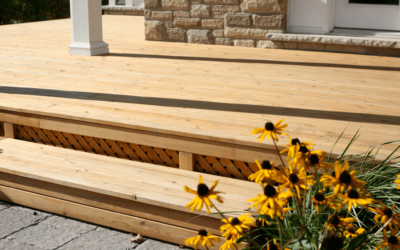Which material should you choose when building a deck?
If you’re thinking of adding a deck to your backyard, you’ve probably spent hours daydreaming about the color, size, and shape you want, and all the ways you’ll use it. From barbecuing in the summer to chatting with your loved ones on cool fall evenings, the options seem limitless.
But, how much thought have you given to the material you want to use for your deck? We recommend choosing from treated wood or composite decking material. This guide will help you determine which material is right for your deck.
What is a treated deck?
As the name suggests, a treated deck is made from treated wood rather than traditional lumber. Essentially, the wood is treated with preservative chemicals that help extend its lifespan when compared with untreated wood.
As a bonus, because treated wood lasts much longer than untreated wood, fewer trees are cut down when treated wood is used for deck projects. Here at Contract Exteriors, we’ve found that Southern Yellow Pine is a great treated wood option that our customers love.
What are some of the advantages of treated wood?
Since this wood is treated with preservative chemicals, treated wood lasts much longer than untreated wood does. In fact, in most cases, treated wood can last up to 25 years, which is five times longer than untreated wood typically lasts.
While all decks are at risk of damage, treated wood is specifically made to protect against the most common issues that break down a deck over time. For example, unlike untreated wood that is susceptible to signs of rot and decay after a few years, treated wood is made to resist rot, leaving you with an intact deck for much longer.
Similarly, The preservatives used on treated wood drive away bugs, helping to keep your deck free of termites and other insects that may ordinarily cause damage to wood. And, because treated wood is a fire retardant material, your deck is better protected against fire damage, unlike decks made from untreated wood.
Now that you know more about treated wood, let’s take a closer look at one of our other favorite options: composite decking material.
What is a composite deck?
Composite decks are made from a durable material that is made up of wood particles and plastic. The wood used in composite decks can be sawdust, wood chips, wood fiber, etc.
The plastics used in the material are often from recycled sources, making composite decks a more environmentally friendly option compared to other deck materials.
What are some of the advantages of composite decks?
As we mentioned above, composite decks are considered to be one of the most eco-friendly deck materials on the market. If “going green” is one of your priorities, then a composite deck is your best option.
Like treated wood, composite decks are also highly resistant to rot and the material won’t warp or splinter over time. What’s even better is that composite decks are extremely durable, so your deck will never have to be painted, sealed, or stained over the years. There’s very minimal maintenance required, giving you more time to sit back, relax, and enjoy your outdoor space.
We offer composite decks in a variety of styles and colors, so you’re sure to find something that complements your home and matches your design aesthetic.
What are the biggest differences between treated wood and composite decks?
So, how do you know if you should choose to build a treated wood deck or a composite one? Well, that depends on your priorities! Here’s a closer look at what sets these two options apart.
Materials
Like we covered above, the biggest difference is the materials from which they’re made. To recap, treated wood is made from wood that has been treated with preservatives, while composite decking is made from a mixture of wood and recyclable plastics.
Cost
Ultimately, cost is determined by the size and shape of your deck, but generally speaking, composite decks are more expensive than treated wood, at least upfront. But, it’s worth factoring in maintenance costs. Since composite decks are virtually maintenance-free, the initial cost might be higher than treated wood, but the lifetime costs could be lower.
Maintenance
While treated wood decks require much less maintenance than untreated wood, composite decks are the lowest maintenance option, by far. Treated wood will require staining, painting, sealing, and sanding over time, while composite decks will maintain their original appearance for years to come.
If you enjoy doing occasional outdoor maintenance, treated wood may be right for you. If you’d prefer to “set it and forget it,” then a composite deck is probably a better option.
What are some of the similarities?
No matter which option you choose, you can have peace of mind that both treated wood and composite decks will look beautiful and fit in with the overall aesthetic of your home. And, since both materials are fire retardant and resistant to rot and insects, you’ll be able to enjoy your deck without having to worry about these issues for years.
To sum it up, both treated wood and composite decks are high-quality materials, and the driving factors that determine which one you choose will likely come down to three things:
- The amount of money you want to spend
- The amount of maintenance you want to do
- The importance to you of using environmentally friendly materials
So, which one will you choose?
Now that you have a better understanding of treated wood and composite decks, it’s time to decide which one you want to use for your deck project!
Regardless of what you choose, Contract Exteriors is here to build the deck you’ve always wanted. When you work with our team of experts, you’ll get a high-quality project with a focus on customer service.
We’ll put your needs first and foremost, and always operate with complete transparency, from start to finish. Contact us today to get a free quote, go over our financing options, or to learn more about how we can turn the deck of your dreams into a reality.



